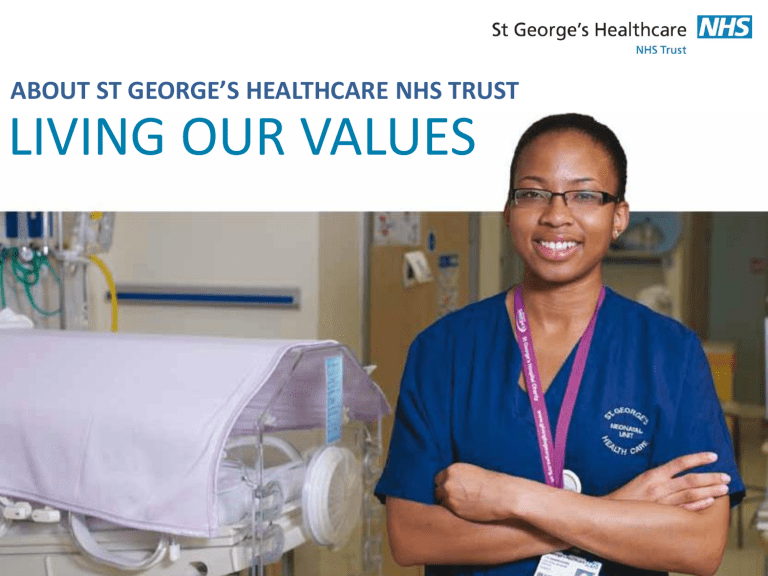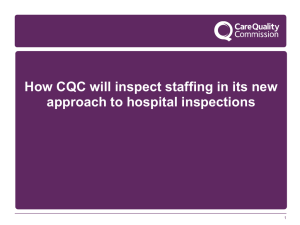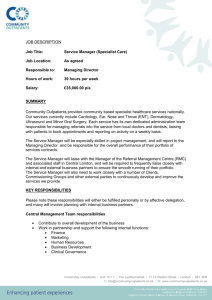Further action - St George`s Hospital

ABOUT ST GEORGE’S HEALTHCARE NHS TRUST
LIVING OUR VALUES
TRUST REFLECTIONS
Thank you to the team for a very fair inspection
We welcome the results of the inspection, which we are using to ensure that our quality improvement effort is focused on the right areas
We have been on a journey of improvement over the past 12 – 18 months
The process of preparation for this inspection has already led to improvements and that work will continue
We are pleased to see from the report that many of the improvements made following previous inspections and through previous quality improvement have been evidenced e.g. maternity, A&E, medicines management, infection control
RATINGS
St. George’s (acute)
Safe
A&E
Medical care
Good
Requires Improvement
Surgery
ITU/CCU
Maternity
Children & Young People
End of Life Care
Outpatients
Overall
Requires Improvement
Outstanding
Good
Good
Requires Improvement
Requires Improvement
Requires Improvement
Effective
Not assessed
Good
Good
Good
Good
Good
Good
Not assessed
Good
Caring
Good
Good
Good
Good
Outstanding
Good
Good
Good
Good
Good
Good
Good
Good
Good
Good
Responsive
Good
Good
Good
Well led
Good
Good
Good
Outstanding
Good
Good
Requires Improvement
Good
Good
Overall
Good
Good
Good
Outstanding
Good
Good
Requires Improvement
Good
Good
QMH (community)
Safe
A&E (Minor Injuries Unit) Requires Improvement
Surgery
Outpatients
Community Inpatient Services
Good
Good
Not rated at this time
Overall Requires Improvement
Effective
Not able to rate
Good
Not able to rate
Not rated at this time
Good
Caring
Good
Good
Good
Not rated at this time
Responsive
Good
Not rated at this time
Well led
Good
Good
Requires Improvement
Good
Good
Not rated at this time
Good Good Good
Overall
Good
Good
Good
Not rated at this time
GOOD
TRUST REFLECTIONS
We’re very pleased that the overall rating is ‘good’ and that this has been consistently achieved across all our services. This is a recognition of the quality of the services we provide.
Also pleased to see that some of our services are recognised as being outstanding e.g. critical care, quality of care in maternity, MIU at QMH.
We need to share that outstanding practice internally and externally.
We welcome the feedback from staff, that they are proud to work here, and from patients.
TRUST REFLECTIONS
We also recognise from what we already know and also the inspection findings that there is still work to do and the focus of our quality improvement this next year will include those areas identified as needing improvement.
The trust is proud of its record on safety of services, but we can always improve and this report has highlighted some specific areas of improvement in safety, including DNAR forms, staff awareness of MCA and outpatients.
We will take action where improvement is required – these will be our priority – but we will also continue improvement work in other areas where we know we can improve.
QUALITY IMPROVEMENT STRATEGY
• We have a quality improvement strategy which sets out our quality priorities to 2017, last updated March 2014.
• The strategy and implementation plan reflects some of the issues raised in the inspection report:
– Ensure that ward establishments are adequate to provide safe, effective care
– Improve learning and staff feedback from reported incidents
– Reduce avoidable grade 3&4 pressure ulcers
– Introduce dementia and delirium team and continue to embed the
Butterfly scheme
– Ensure compassionate care at the end of life is supported and monitored
– Improve patient experience in outpatient department
TRUST ACTIONS
MENTAL CAPACITY ACT
The report notes that most staff had attended or completed training on safeguarding adults, and there was appropriate specialist input via the safeguarding lead and two learning disability nurses.
However the report identifies varied levels of understanding of the MCA:
• ‘We found there was a poor general understanding and implementation of the principles of the Mental Capacity Act across some services at [Queen Mary’s] hospital’
• ‘We looked at patient notes and records on two wards we visited. We did not see any consistent approach to documenting decisions regarding people’s mental capacity to make specific decisions. We did not see evidence that the two stage test of mental capacity had been undertaken, even in note of people where capacity was identified to be an issue’
• ‘….the implementation of the Mental Capacity Act was not embedded at a local level and there was a risk that people would not be offered the protection of a robust, documented decision about their capacity to make specific decisions and clear protocols about how best interest decisions were made when someone lacked the capacity to make decisions’.
MENTAL CAPACITY ACT
Action taken
• MCA and DOLS training is included in clinical updates to wards as part of development days.
• MCA and DOLS is included as part of safeguarding training with a 1 hour session aimed at registered nurses.
• Ad hoc sessions are also available to other staff groups on demand.
Further action
• Review of induction in light of the findings.
• Involvement of medical staff and leadership from clinical directors - knowledge & documentation.
• Plan levels of training - this is likely to form three different levels of training (from basic to more advanced) and focus on staff groups most likely to need more detailed training.
• The immediate focus will be on "high risk" areas that will need more input especially re DOLS . The target will be for 75% of relevant staff to have received training.
• Design an audit to review cases with clinical audit team: audit outcomes will demonstrate appropriate use of DOLS and evidence of proper application of MCA principles include use of Best
Interest meetings and checklists.
END OF LIFE CARE
We are proud of our end of life care team and so welcome the feedback in the report that the palliative care team worked well for patients who are recognised as being at the end of their life and particularly that the end of life care in the maternity department was considered to be exceptional and the mortuary and bereavement services as excellent.
We have good governance processes around end of life care, led by an end of life care steering group and the Chief Nurse at board level. Following the withdrawal of the LCP we have adopted LCA best practice while we wait for national guidance , have implemented a number of actions and have a range of performance metrics to monitor progress in this service.
We recognise the CQC’s findings regarding the accurate completion of DNA CPR forms and will review the documentation and re-audit to ensure improvement in this area. We also need to ensure that all staff understand the palliative care service available.
END OF LIFE CARE
Action taken
• Prompt actions taken following removal of LCP and adoption of LCA best practice whilst awaiting national guidance
• EOLC Audit to ensure patient care not affected (positive results)
• Self assessment/benchmark against Neuberger report recommendations
• Completed Peer review self assessment 2012/13 – achieved 96%
• Achieved CQUINs 2011-14 – Education & Advanced Care Planning (CMC/GSF)
• Sage & Thyme training and other ongoing education programmes
• Review of LACDP guidance
• Expansion of Fast Track service, year on year increase in patient numbers and increasing achievement of patients PPC/PPD (89.75 % 2013/14 patients 1 st or 2 nd choice PPC)
Further action
• Review DNA CPR documentation and training and repeat audit (annually)
• Repeat local EoLC audit to ensure patient care not affected (in progress)
• Continuing to expand use of Coordinate My Care and Gold Standard Framework
• Wider engagement in Advanced Care Planning
• Review number of palliative care CNSs in order to meet future service needs depending on National
LACDP guidance.
12
OUTPATIENTS
The inspection report has found the trust’s outpatients department to be overall good, with most patients telling the CQC that they were satisfied with the service they had received and had experienced a very caring approach by staff.
However the report highlights areas of safety within the outpatients service where improvements are required:
“There was a reliance on temporary records as medical records were often unavailable.
Patients’ paper records were not always kept securely and confidentiality was often breached.”
“Staff knew that there was a regular problem with overbooking of clinics, but did not seem to understand why or how this could be better managed”
“Safe staffing levels with appropriately qualified and experienced staff was a challenge.”
13
OUTPATIENTS
Action taken
• Agreed that improvement in outpatients service is a priority in our quality improvement strategy and included in our improvement programme for 2014/15
• Project established in January 2014, with five workstreams:
1. Technology:
• Redesign CBS layout for additional staff (May 2014),
• Self check-in booths (May 2014),
• Notes tracking ‘tracking week’ (28 April 2014)
2. Environment
• Phase 1 environmental audit completed
3. Business rules
• Reinforced existing business rules with clinical teams (six week cancellation rule)
• Daily / weekly dashboard produced to monitor performance of departments / specialties
14
OUTPATIENTS
4. Engagement with clinicians
• Vascular (nursing support now allocated, one clinic moved to AMW)
• Urology (nursing roles reviewed and reinvestment in staff, key metrics defined to identify further improvements)
• Therapies (cashing up, scheduling of patients)
5. Engagement with patients
• Presentations to Patient Experience Committee and Patient Reference Group. Patient
‘champions’ invited to join the project.
Further action
• Notes tracking
– implement actions from ‘tracking week’ (28 April 2014)
–
– investment in substantive staff audits to ensure compliance across divisions
• Phase 2 environmental survey scheduled for 17 April, to include patient representatives
• Business rules – sign off on a set of rules with divisions (end May 2014).
15
CONCERNS RAISED BY STAFF ABOUT
ALLEGATIONS OF BULLYING
Overall the inspection report found that staff felt proud to work in the trust and sickness rates were low. In most areas, local leaders were described as ‘supportive and encouraging’.
However the CQC highlighted to the trust a number of specific cases where concerns had been raised by members of staff during the inspection, involving allegations of bullying and harassment.
Our approach
All members of staff are expected to behave according to the Trust’s values and no-one is exempt.
Our analysis shows that often staff concerns tend to be about low level poor behaviour and can be addressed through coaching, mediation and other support to managers and members of staff.
We will continue to provide support to staff to help them to manage their behaviour but for those who are unable to improve or whose behaviour is very serious we will take appropriate action, such as dismissal.
16
CONCERNS RAISED BY STAFF ABOUT
ALLEGATIONS OF BULLYING
Action taken
• Seven cases identified were examples of the range of issues about relationships, behaviour and attitude that arise. In all but one case, issues raised were known to line management and action already underway.
• All individuals told of concerns and offered support to ensure that they are not subject of further concerns. Support includes coaching, team building or providing an opportunity to gain feedback about the impact of their behaviour on others.
• In some cases individuals already moved to more suitable roles or left the trust.
• Senior level commitment to tackling poor behaviour – EMT agreed principles for commitment, based on expectation that all staff will behave according to trust values.
Further action
• To continue with the programme of intensive organisational development support work focused on specific areas, such as maternity, where we have seen real improvement.
• Publish senior level commitment to tackling poor behaviour
• Raising greater awareness / training events on unconscious bias
• Developing DVD about staff experiences
17
SAFE STAFFING LEVELS
We are pleased to note that the inspection found that there were enough nursing staff to deliver care safely in A&E, Medical Care, Critical Care and Maternity.
The report highlights particular issues in levels of staffing in Children and Young
People wards and in Outpatients.
We had recognised issues in both these areas prior to the inspection and recruitment plans are in place.
Other measures we have in place to ensure that we minimise any risk to patients include:
• An established safe staffing policy with daily monitoring of staffing levels;
• Proactive sickness management
18
SAFE STAFFING LEVELS
Action taken
• Safe staffing policy and escalation revised
• Implementation of acuity & dependency tool
• Robust review of establishments almost complete (May board)
• Proactive recruitment campaigns and assessment centres for nursing staff recruitment
• Improve clinical leadership in COS
– New post of Head of Nursing now in place
– Establishment review underway across all outpatients, incorporating skill mix review
– Prompt recruitment when vacancies arise
• Workforce plan developed for children’s
– Ongoing recruitment of band 5 nurses at trust regular monthly assessment days
– Use of agencies for overseas recruitment
– Planned visit to Scotland for recruitment following attendance at recruitment fair in Glasgow
– Clinically based teacher to support students – and aid recruitment on qualification
– Part-time practice educator in place; full-time post advertised
– Plan for neurology trained CNS to be ward based to support staff
19
SAFE STAFFING LEVELS
Further action
In line with NQB requirements:
• Repeat establishment review every 6 months with review of acuity/dependency data
• Implement monthly reporting to board – workforce and quality metrics
• Display data on public facing website
• Display planned versus actual staffing in real time in clinical areas
20
COMMUNITY
The inspection report highlights some good practice in our community services:
“ We saw excellent examples of multidisciplinary working across the community and acute teams, including discharge of patients and management of complex disorders”
“Women and their partners in the maternity and critical care settings were particularly pleased with the care they received. As were patients who used the community services that the trust provides.”
“The services at Queen Mary’s Hospital enabled patients to move from acute care back into the community in a more timely manner.”
We also recognise that further work is required to support our community staff:
“The trust should review the integration of the IT system and ensure a prompt response to community IT issues”
“Senior managers should be more visible in the community settings to enhance leadership.”
“The relevance of communication that is cascaded to community staff should be strengthened where appropriate.”
21
COMMUNITY
Actions taken
• Working with commissioners to design community adult services
• Options for closer integration of IT infrastructure has been commissioned. Domains will be brought together post migration of key clinical information services from national to local service provision.
• IT service desk performance is reviewed and reported to the Trust ICT user group which includes both community and acute staff representation
• Board meetings now held at QMH for 2/6 meetings per year
• Quality inspections extended to community locations, including trust senior management
• Listening into Action ‘Big conversations’ being held in community locations
Further action
• Staff newsletter launch May 2014 – to include community specific stories
22
CONCLUSION
• We welcome the findings of the report
• We will use the findings to continue to improve our services, as part of our continual improvement in quality
• We will develop a detailed action plan, implementation of which will be monitored through our existing governance structures
• We will share good practice internally and externally





